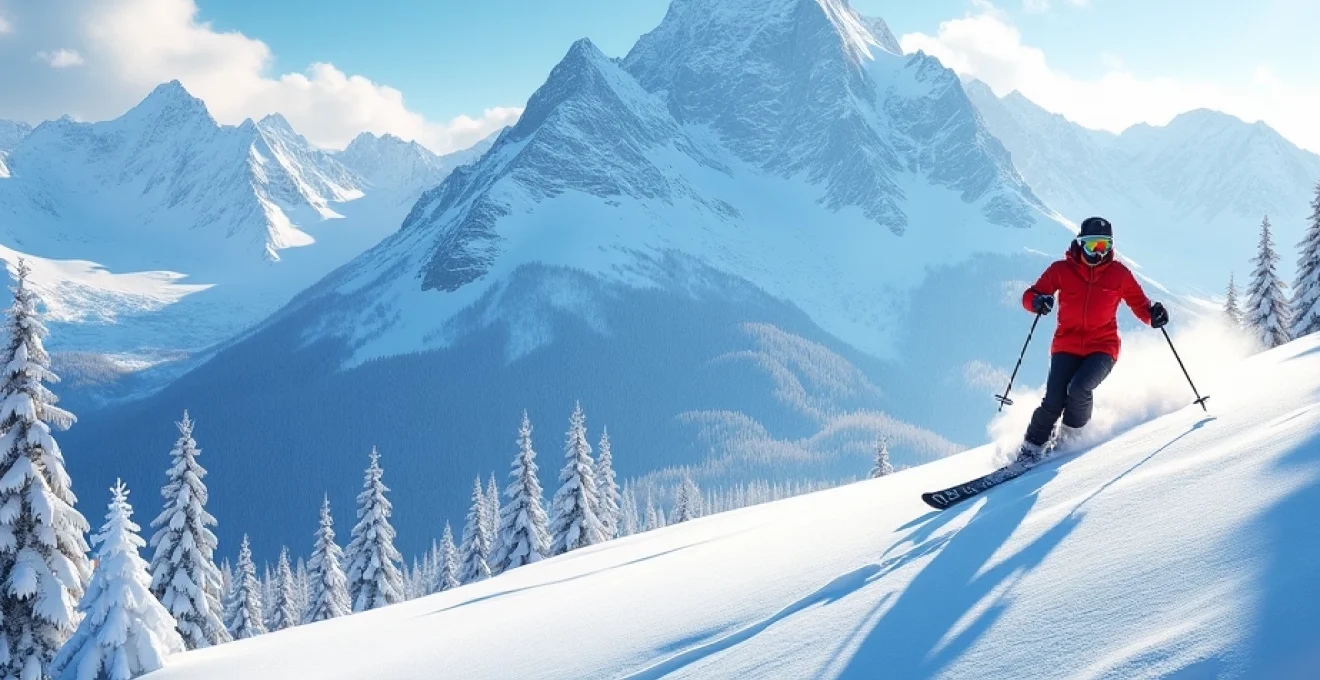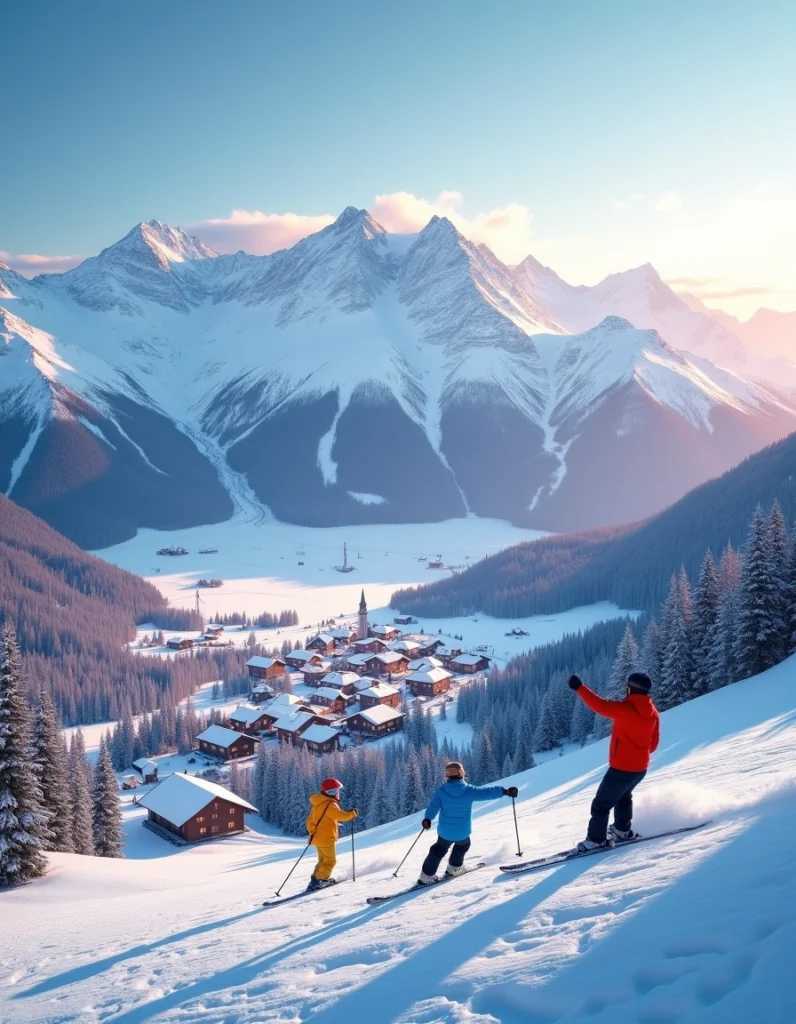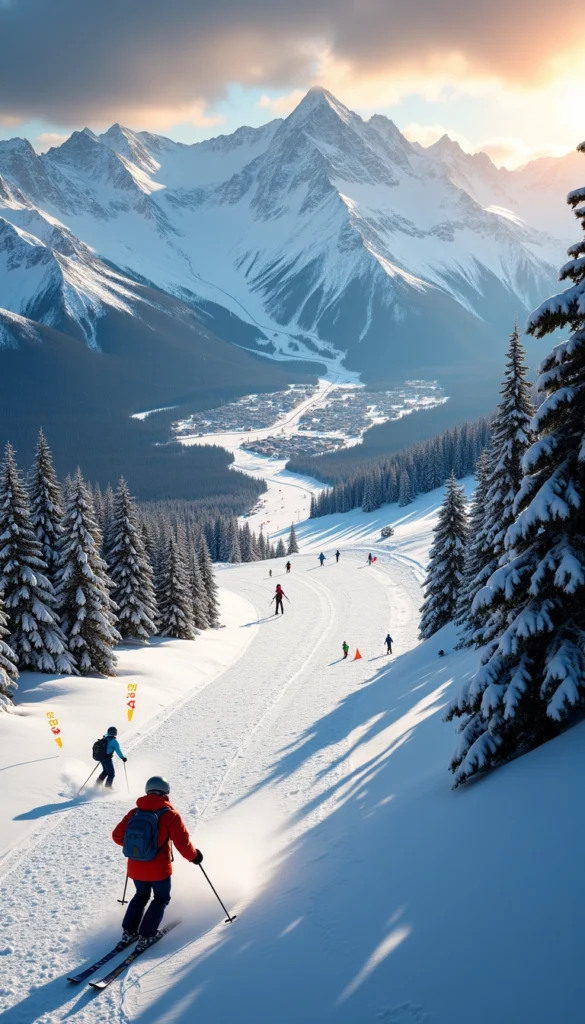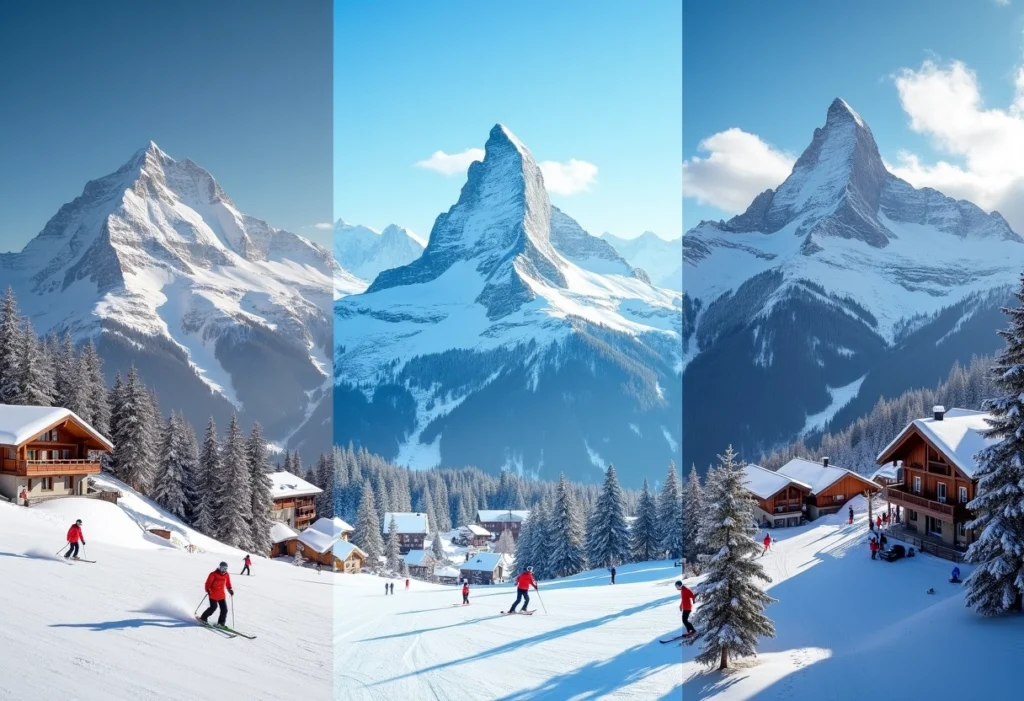
The majestic Alps offer an unparalleled winter sports experience, drawing ski enthusiasts from around the globe to its pristine slopes and world-class resorts. With breathtaking scenery, challenging terrain, and a rich alpine culture, skiing in the Alps is a bucket-list adventure for many. From family-friendly slopes to heart-pounding off-piste runs, the diverse range of options caters to every skill level and preference. As you plan your next winter getaway, explore the top Alpine destinations that combine exceptional skiing with unforgettable mountain experiences.
Top alpine ski destinations: Courchevel, Zermatt, and St. Anton
When it comes to premier skiing in the Alps, three resorts consistently stand out for their exceptional offerings: Courchevel in France, Zermatt in Switzerland, and St. Anton in Austria. Each of these destinations boasts unique characteristics that make them sought-after by ski enthusiasts and luxury travelers alike. High-end real estate rentals in Courchevel provide access to the resort’s finest slopes, as well as proximity to fine dining, exclusive après-ski experiences, and world-class shopping. Whether you’re looking for a private chalet or a penthouse apartment, the accommodations here are designed to meet the highest standards of comfort and style.
Courchevel, part of the expansive Les 3 Vallées ski area, is renowned for its glamorous atmosphere and impeccable slopes. With a total of 600 kilometers of interconnected runs, it offers an unparalleled ski playground. The resort is divided into several villages, each with its own charm and price point, ensuring options for various budgets and preferences.
Zermatt, nestled at the foot of the iconic Matterhorn, offers a truly magical Alpine experience. This car-free resort combines traditional Swiss charm with modern amenities and some of the most reliable snow conditions in Europe. Its high-altitude slopes and glacier skiing provide an extended season, often allowing you to hit the slopes well into spring.
St. Anton, located in Austria’s Arlberg region, is famous for its challenging terrain and vibrant après-ski scene. Known as the cradle of Alpine skiing, it offers a perfect blend of advanced runs, extensive off-piste opportunities, and a lively village atmosphere that keeps visitors coming back year after year.

Terrain analysis: piste difficulty and Off-Piste opportunities
Courchevel’s diverse ski runs: from gentle greens to challenging blacks
Courchevel’s ski terrain is a testament to its versatility, catering to skiers of all abilities. The resort boasts an impressive array of 150 kilometers of slopes within its immediate area, ranging from wide, gentle green runs perfect for beginners to steep, mogul-filled black runs that challenge even the most experienced skiers.
For novices, the Verdons and Biollay sectors offer spacious, well-groomed green runs where you can build confidence. Intermediate skiers will find a paradise of red runs, particularly in the Creux Noirs and Saulire areas, where long, sweeping descents provide thrilling yet manageable challenges.
Advanced skiers can test their mettle on Courchevel’s black runs, such as the infamous Jockeys and Jean Blanc pistes. These runs offer steep gradients, tight turns, and often moguls, providing an exhilarating experience for those seeking an adrenaline rush.
Zermatt’s glacier skiing and High-Altitude powder fields
Zermatt’s unique selling point is its high-altitude terrain and year-round skiing opportunities. The Matterhorn Glacier Paradise, reaching an impressive 3,883 meters, offers skiers access to some of the highest slopes in Europe. This elevation ensures excellent snow conditions throughout the extended season, often stretching from late November to early May.
The Theodul Glacier area is a haven for intermediate and advanced skiers, with wide, open runs that seem to go on forever. For those seeking fresh powder, Zermatt’s off-piste opportunities are legendary. The Stockhorn and Rothorn areas offer extensive freeride terrain, where you can carve fresh tracks through untouched snow fields.
Zermatt also boasts the opportunity to ski across the Italian border to Cervinia, adding an international flair to your ski day. This cross-border skiing opens up even more terrain and allows you to experience two distinct Alpine cultures in one trip.
St. Anton’s renowned Valluga and Schindler Kar freeride areas
St. Anton is a mecca for advanced skiers and powder hounds, with some of the most challenging terrain in the Alps. The Valluga area, accessible via a series of lifts culminating in a tiny cable car, offers heart-pounding descents and breathtaking views. From the summit at 2,811 meters, expert skiers can tackle the notorious north face, a steep, off-piste run that demands respect and skill.
The Schindler Kar area is another freeride paradise, offering extensive off-piste terrain that feels wonderfully remote despite being within the resort boundaries. Here, you’ll find deep powder bowls, challenging chutes, and natural half-pipes that provide an playground for experienced skiers and snowboarders.
While St. Anton is famous for its advanced terrain, it also caters to intermediates with a network of well-groomed red runs. The Rendl area, in particular, offers some excellent intermediate pistes with a more relaxed atmosphere than the main resort area.
Avalanche safety and backcountry access in alpine resorts
With great powder comes great responsibility, and all three resorts take avalanche safety seriously. Each resort offers guided off-piste tours and avalanche safety courses, which are highly recommended for anyone venturing beyond the marked runs. It’s crucial to remember that even within resort boundaries, off-piste areas are not patrolled or avalanche controlled.
In Courchevel, the Avalanche Risk Center provides daily bulletins and educational programs. Zermatt’s Air Zermatt offers heli-skiing experiences with expert guides, combining safety with unparalleled access to remote powder fields. St. Anton’s Arlberg Guides office is a valuable resource for backcountry enthusiasts, offering expert guidance and local knowledge.
Always check the local avalanche forecast, carry proper safety equipment (transceiver, shovel, and probe), and consider hiring a guide when exploring unfamiliar backcountry terrain. Remember, no powder run is worth risking your life – safety should always be your top priority in the mountains.

Alpine ski infrastructure: lifts, Snow-Making, and resort facilities
Courchevel’s State-of-the-Art lift system: capacity and speed analysis
Courchevel prides itself on having one of the most modern and efficient lift systems in the world. The resort has invested heavily in high-speed chairlifts and gondolas, significantly reducing waiting times and maximizing ski time. The lift network can transport an impressive 260,000 skiers per hour across the entire Les 3 Vallées area.
A standout feature is the Saulire Express gondola, which whisks skiers from Courchevel 1850 to the summit of Saulire (2,738m) in just 12 minutes. This state-of-the-art lift can carry up to 2,400 people per hour, ensuring minimal queues even during peak periods.
The resort also boasts several high-speed detachable chairlifts, such as the six-seater Chenus lift, which features heated seats and protective bubbles – a welcome luxury on cold or snowy days. This attention to comfort and efficiency is a hallmark of Courchevel’s commitment to providing a premium ski experience.
Zermatt’s Year-Round skiing: Matterhorn glacier paradise
Zermatt’s crown jewel in terms of infrastructure is undoubtedly the Matterhorn Glacier Paradise. This engineering marvel includes the highest cable car station in Europe, sitting at a breathtaking 3,883 meters above sea level. The three-stage journey to the summit takes about 45 minutes and offers panoramic views of the surrounding Alpine peaks.
The glacier area is equipped with modern T-bar lifts that are designed to operate in high-altitude conditions, ensuring access to the slopes even in challenging weather. Zermatt’s commitment to year-round skiing is evident in its continuous investment in high-altitude infrastructure, including snow-making capabilities that extend well above 3,000 meters.
An impressive feature of Zermatt’s lift system is the 3S Matterhorn Glacier Ride, a tri-cable gondola that can operate in winds up to 120 km/h, significantly reducing weather-related closures. This lift can transport up to 2,000 skiers per hour, providing reliable access to the glacier slopes.
St. Anton’s Galzig and Valluga cable cars: engineering marvels
St. Anton’s lift system is a blend of historic significance and modern innovation. The Galzig cable car, first opened in 1937, has been continually updated and now features a unique ferris wheel-like station that allows for easy boarding. This ingenious design improves efficiency and accessibility, especially for families and beginners.
The crown jewel of St. Anton’s infrastructure is the Valluga cable car. This two-stage journey takes skiers to the resort’s highest point at 2,811 meters. The final leg, Valluga II, is a tiny 5-person cable car that accesses the most challenging terrain. Access to Valluga II is restricted to skiers accompanied by a guide, underlining the extreme nature of the terrain it serves.
St. Anton has also invested in several high-speed chairlifts across the resort, such as the Schindlergrat triple chair, which provides quick access to some of the best off-piste terrain in the area. These modern lifts, combined with the resort’s historic cable cars, create an efficient system that can handle high volumes of skiers while maintaining the charm of a traditional Alpine resort.
Snow-making technology in Low-Altitude alpine resorts
While high-altitude resorts like Zermatt often benefit from reliable natural snowfall, lower-lying resorts have invested heavily in snow-making technology to ensure consistent conditions throughout the season. Courchevel, for instance, has snow-making capabilities on 50% of its slopes, with a particular focus on lower altitude runs and key connecting pistes.
Modern snow-making systems use advanced computer controls to optimize water and energy use based on temperature, humidity, and wind conditions. Many resorts now employ snow farming techniques, where snow is stockpiled and covered during the summer months to be redistributed in the early season.
St. Anton, despite its reputation for excellent natural snow, has also invested in extensive snow-making infrastructure. This ensures that even in lean snow years, the resort can maintain good coverage on its main runs and important connecting routes.
Snow-making technology has revolutionized Alpine skiing, extending the season and providing more reliable conditions. However, it’s important to consider the environmental impact and water usage of these systems.

Apres-ski culture and entertainment in alpine resorts
The Alpine après-ski scene is as diverse and exciting as the skiing itself, with each resort offering its own unique flavor of post-slope entertainment. From sophisticated wine bars to raucous mountain huts, there’s something for every taste and energy level.
In Courchevel, the après-ski scene tends towards the luxurious and refined. You’ll find chic bars and lounges where you can sip champagne and nibble on gourmet canapés while recounting the day’s adventures. La Folie Douce, located at the top of La Saulire gondola, offers a more energetic experience with its famous outdoor parties featuring live music and dancers.
Zermatt’s après-ski offerings blend traditional Swiss charm with modern entertainment. The Hennu Stall, at the base of the Matterhorn Express gondola, is a popular spot for skiers looking to unwind with live music and a lively atmosphere. For a more relaxed evening, the Champagne Bar at the Riffelalp Resort offers stunning Matterhorn views and an extensive champagne menu.
St. Anton is renowned for its vibrant and sometimes wild après-ski scene. The legendary MooserWirt and Krazy Kanguruh bars are institutions, known for their table-dancing and party atmosphere. For those seeking a quieter evening, the village offers numerous traditional Austrian taverns where you can enjoy local specialties and schnapps in a cozy setting.
Beyond drinking and dancing, these resorts offer a range of evening activities. Courchevel boasts a cinema and bowling alley, Zermatt offers night sledding on floodlit runs, and St. Anton provides guided night ski tours for a unique Alpine experience.
Sustainable skiing: Eco-Friendly initiatives in alpine resorts
As awareness of climate change and environmental issues grows, Alpine ski resorts are increasingly focusing on sustainability and eco-friendly practices. Many resorts are implementing innovative solutions to reduce their environmental impact while still providing world-class ski experiences.
Zermatt has been a pioneer in sustainable tourism, with its car-free village policy dating back to 1961. The resort runs on 100% renewable energy and has implemented an extensive recycling program. Its electric buses and taxis, powered by locally-produced hydroelectricity, showcase how a busy ski resort can operate with minimal carbon emissions.
Courchevel has invested in energy-efficient snowmaking systems and is gradually transitioning its grooming fleet to more eco-friendly models. The resort has also implemented a comprehensive waste management system and encourages visitors to use public transportation to reduce traffic and emissions in the valley.
St. Anton, as part of the Arlberg region, has been working on various sustainability projects. These include optimizing their snowmaking systems to use less energy and water, investing in solar power for mountain restaurants, and promoting the use of public transportation for visitors arriving in the region.
Sustainable skiing is not just about preserving the environment – it’s about ensuring that future generations can continue to enjoy these magnificent Alpine playgrounds.
Planning your alpine ski trip: transportation, accommodation, and ski passes
Geneva and Zurich airports: gateway hubs for alpine ski resorts
For many international visitors, Geneva and Zurich airports serve as the primary gateways to the Alps. Geneva is particularly well-situated for accessing French resorts like Courchevel, while Zurich is often the preferred option for those heading to Austrian destinations like St. Anton.
Both airports offer excellent connections to major cities worldwide and are well-equipped to handle ski equipment. Upon arrival, you’ll find numerous transfer options, including trains, buses, and private shuttles, to whisk you away to your chosen resort.
It’s worth noting that during peak ski season, these airports can be extremely busy. Booking your transfers in advance and allowing plenty of time for connections is advisable to ensure a smooth start to your ski holiday.
Mountain railway networks: accessing Car-Free resorts like Zermatt
Switzerland’s efficient mountain railway network is a marvel of engineering and provides a scenic and sustainable way to reach many ski resorts. Zermatt, being a car-free resort, is primarily accessed by train. The final leg of the journey from Täsch to Zermatt is particularly picturesque, winding through the narrow Mattertal valley with the Matterhorn looming ahead.
These mountain railways not only provide access to the resorts but often form an integral part of the ski infrastructure. In Zermatt, for example, the Gornergrat railway doubles as a ski lift, whisking skiers up to 3,089 meters for some of the most spectacular runs in the resort.
Using public transportation to access and navigate these resorts not only reduces your carbon footprint but also allows you to sit back and enjoy the stunning Alpine scenery without the stress of driving on winter roads.
Multi-resort ski passes: Arlberg Card and Les 3 Vallées
For those looking to maximize their skiing options, multi-resort ski passes offer excellent value and flexibility. The Arlberg Card, which covers St. Anton and several neighboring resorts, provides access to 305 kilometers of marked ski runs and 200 kilometers of off-piste terrain. This pass allows you to explore the entire Arlberg region, including the resorts of Lech, Zürs, and Stuben.
The Les 3 Vallées ski pass, which includes Courchevel, offers an even more extensive ski area. With 600 kilometers of interconnected pistes, it’s the largest linked ski area in the world. This pass allows you to ski from Courchevel to Méribel to Val Thorens, experiencing a vast range of terrain and mountain scenery along the way.
Both of these multi-resort passes offer excellent value for avid skiers looking to explore diverse terrain during their Alpine vacation. They also provide flexibility, allowing you to chase the best snow conditions across multiple resorts without being tied to a single location.
Alpine accommodation options: from luxury chalets to Budget-Friendly hostels
The Alps cater to a wide range of budgets and preferences when it comes to accommodation. From opulent chalets to cozy apartments and budget-friendly hostels, there’s something for everyone.
In Courchevel, luxury is the name of the game. The resort boasts numerous five-star hotels and exclusive chalets, particularly in Courchevel 1850. These high-end accommodations often come with amenities like private spas, in-house chefs, and ski-in/ski-out access. For those seeking a more modest option, the lower villages of Courchevel offer a range of self-catering apartments and mid-range hotels.
Zermatt’s accommodation options reflect its car-free, traditional charm. Many hotels and chalets are family-run, offering a personal touch to your stay. The resort features a mix of luxury hotels with Matterhorn views, boutique chalets, and more affordable options in the outskirts of the village. For budget-conscious travelers, Zermatt also has a few hostels and budget hotels, though these can fill up quickly during peak season.
